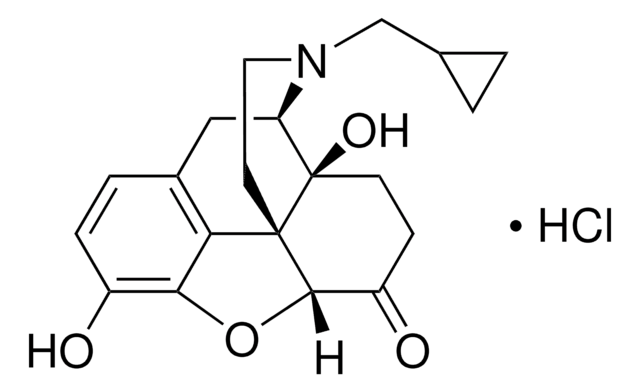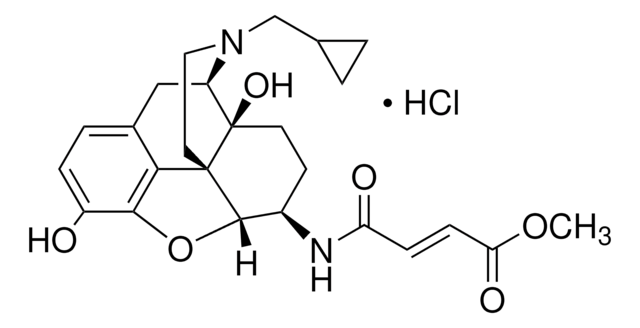B8312
BNTX maleate salt hydrate
≥98% (HPLC)
Sinonimo/i:
7(E)-Benzylidenenaltrexone maleate salt hydrate, BNTX-7 maleate salt hydrate, Morphinan-6-one,17-(cyclopropylmethyl)-4,5-epoxy-3,14-dihydroxy-7-(phenylmethylene)-,(5a,7E)- maleate salt hydrate
About This Item
Prodotti consigliati
Livello qualitativo
Saggio
≥98% (HPLC)
Forma fisica
powder
Condizioni di stoccaggio
desiccated
Colore
yellow
Solubilità
DMSO: >20 mg/mL
Temperatura di conservazione
−20°C
Stringa SMILE
O.OC(=O)\C=C/C(O)=O.Oc1ccc2C[C@H]3N(CC[C@@]45[C@@H](Oc1c24)C(=O)\C(C[C@@]35O)=C\c6ccccc6)CC7CC7
InChI
1S/C27H27NO4.C4H4O4.H2O/c29-20-9-8-18-13-21-27(31)14-19(12-16-4-2-1-3-5-16)23(30)25-26(27,22(18)24(20)32-25)10-11-28(21)15-17-6-7-17;5-3(6)1-2-4(7)8;/h1-5,8-9,12,17,21,25,29,31H,6-7,10-11,13-15H2;1-2H,(H,5,6)(H,7,8);1H2/b19-12+;2-1-;/t21-,25+,26+,27-;;/m1../s1
AGUNLJBLOJAUKM-ZKJXOIBSSA-N
Applicazioni
Azioni biochim/fisiol
Caratteristiche e vantaggi
Avvertenze
Warning
Indicazioni di pericolo
Consigli di prudenza
Classi di pericolo
Aquatic Acute 1 - Eye Irrit. 2
Codice della classe di stoccaggio
11 - Combustible Solids
Classe di pericolosità dell'acqua (WGK)
WGK 3
Punto d’infiammabilità (°F)
Not applicable
Punto d’infiammabilità (°C)
Not applicable
Dispositivi di protezione individuale
dust mask type N95 (US), Eyeshields, Gloves
Certificati d'analisi (COA)
Cerca il Certificati d'analisi (COA) digitando il numero di lotto/batch corrispondente. I numeri di lotto o di batch sono stampati sull'etichetta dei prodotti dopo la parola ‘Lotto’ o ‘Batch’.
Possiedi già questo prodotto?
I documenti relativi ai prodotti acquistati recentemente sono disponibili nell’Archivio dei documenti.
I clienti hanno visto anche
Il team dei nostri ricercatori vanta grande esperienza in tutte le aree della ricerca quali Life Science, scienza dei materiali, sintesi chimica, cromatografia, discipline analitiche, ecc..
Contatta l'Assistenza Tecnica.











